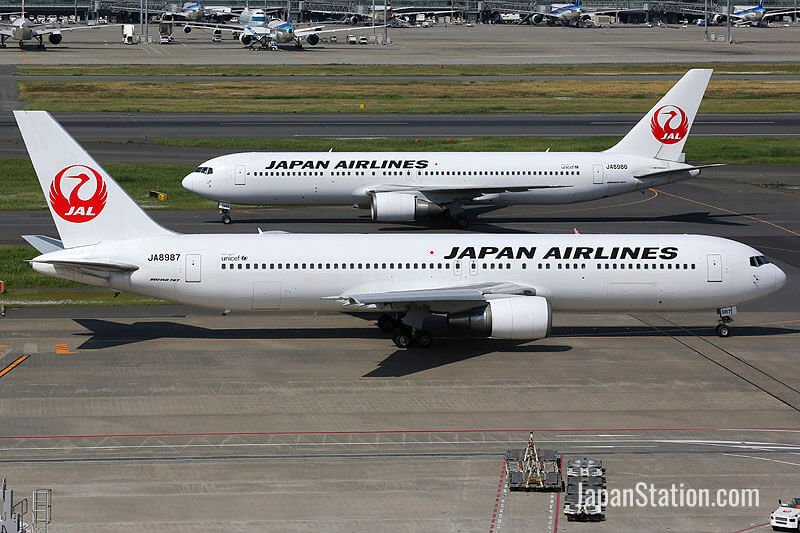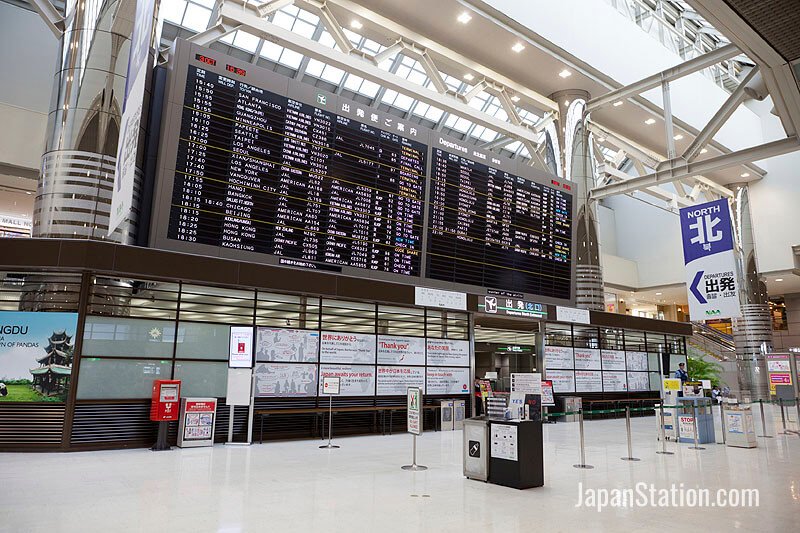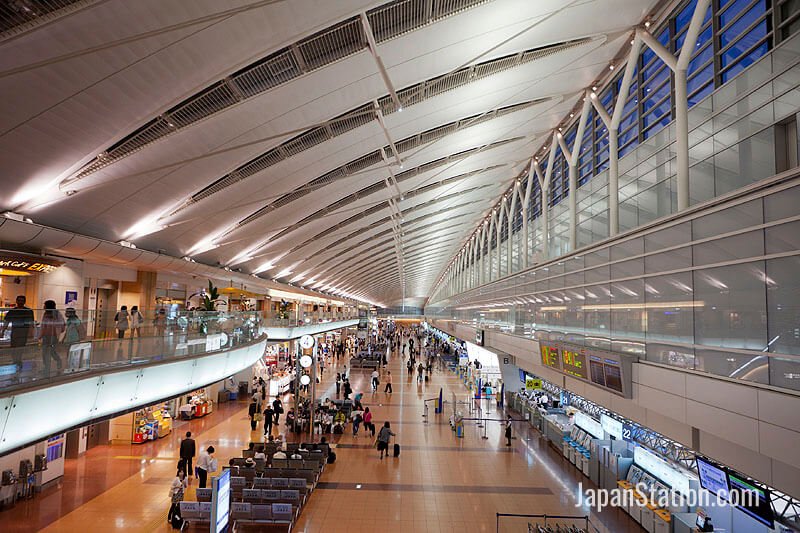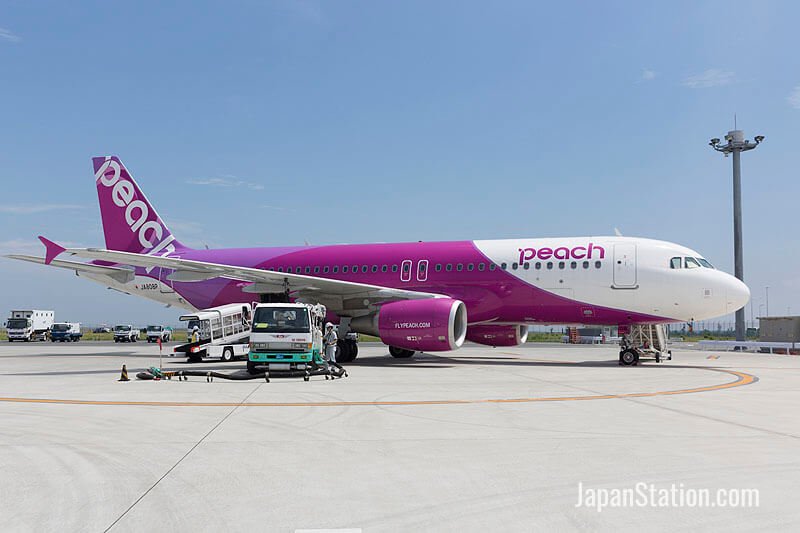It may come as no surprise that Japan, home to the world’s busiest train station, also has some of the busiest air routes in the world. Flights between Tokyo and Sapporo as well as Tokyo and Fukuoka each carry around 8 million passengers per year, ranking only behind Seoul-Jeju as the world’s busiest. But the good news is that flying in Japan is refreshingly efficient, with a premium put on customer satisfaction.

Japan Airlines is one of Japan’s two dominant carriers
Flying in Japan
Few other airports in the world can match Japanese service and punctuality. Large airports have staff doing everything from supervising suitcases sliding down onto luggage carousels to bidding farewell to departing planes with a bow. And that attention to detail doesn’t cause delays. In a global survey by aviation data firm OAG, Osaka and Haneda airports placed first and second for on-time flights in the categories of midsize and large airports.
Japanese airports are notable for their efficiency, speedy rail connections to large cities and the use of artificial islands due to land scarcity. Japan also has well developed courier services, known as takkyubin, that make sending your luggage anywhere in the country a snap. For instance, you could land at Narita International Airport with a heavy load of bags, bring them to a takkyubin counter and they will arrive at your hotel in Tokyo the following day, probably for under 2,000 yen or 3,000 yen depending on weight and size. Takkyubin companies can also forward your luggage to their airport counters for pickup before a flight – but it must be sent at least two days prior to boarding.

Narita International Airport handles 50 percent of all international flights to Japan
Japan has invested extensively to build its highly developed air and rail network. Because of the speed and near ubiquity of railways, however, most Japanese travelers opt for trains when traveling to a city on the same island, such as Tokyo and Osaka. But air travel is the way to go when hopping from Honshu Island to Hokkaido or Kyushu. Japan is also a hub for international flights to East Asia, with easy connections to South Korea, China, Taiwan and Southeast Asia, as well as long-haul flights to cities around the world.
When flying, plan well in advance to avoid holiday crushes when possible. The peak seasons for flying in Japan run from late December to mid-January (for New Year’s holidays), April and May (the variable Golden Week holidays) as well as July and August (the Obon summer holidays); there’s also a smaller-scale Silver Week holiday in mid-September that causes congestion.
Major Airports

Haneda Airport is the world’s fourth-busiest
Tokyo – Haneda
Haneda Airport, also known as Tokyo International Airport, is one of two airports serving Tokyo and the surrounding region. In 2014, it handled nearly 73 million passengers, making it the fourth-busiest airport in the world after Atlanta, Beijing and London Heathrow. Although Haneda lived in the shadow of Narita Airport for decades, mostly handling domestic flights, in 2010 it added an international terminal and never looked back. Located on Tokyo Bay, a relatively quick train or bus ride into the city, and serving 28 international and dozens of domestic destinations, Haneda has become the airport of choice for savvy Tokyoites. Late arrival or an early flight? Find a perfect place to stay at the Haneda Airport Hotel.
Tokyo – Narita
While it isn’t the busiest in terms of total passengers, Narita International Airport is Japan’s main international gateway, serving 50 percent of all international passengers with connections to dozens of cities around the world. Opened in 1978 following violent clashes over farmers’ land rights, Narita handled most international flights for Tokyo until 2010, when Haneda began playing a bigger role. Narita is situated in Chiba Prefecture, 57 kilometers east of central Tokyo as the crow flies, but JR East’s Narita Express and Keisei’s Skyliner trains can cover the distance in under an hour. There are also several hotels near Narita Airport catering to arriving and departing passengers.

Sapporo’s annual snow festival helps make Tokyo-Sapporo one of the world’s busiest air routes
Sapporo, Fukuoka and other hubs
These two airports, the third- and fourth-busiest in Japan respectively, serve as hubs for Hokkaido Island in the north and Kyushu Island in the south. Sapporo’s airport is also known as New Chitose Airport and is flooded with passengers from Tokyo on one of the world’s busiest routes – dozens of flights a day ferry people between the capital and the holiday playground of Hokkaido. Rail and bus connections link the airport with Sapporo as well as ski and other vacation resorts.
In some rankings, Tokyo-Fukuoka is the second-busiest route in the world. Fukuoka Airport lies in central Fukuoka City, only a short distance from the rail hub of Hakata Station. Though it only has a single 2,800-meter runway, Fukuoka has grown its traffic in recent years on the back of low-cost carriers (LCCs). Fukuoka Airport is closer to Seoul, Busan and Jeju in South Korea than to Tokyo, and it has served as a bridge between the two countries.
Japan’s other air gateways include Osaka International Airport and Kansai International Airport serving Osaka, Naha Airport on the main island of Okinawa, and Chubu Centrair International Airport serving Nagoya.

Peach Aviation is a Japanese low-cost carrier serving destinations nationwide as well as South Korea, Taiwan and Hong Kong
Airlines
Air travel in Japan is dominated by Japan Airlines (JAL) and All Nippon Airways (ANA). These two giants not only serve all major cities, their regional counterparts and subsidiaries operate frequent flights to smaller towns and remote islands such as the Okinawan archipelago. Both airlines are renowned for their high-quality service. JAL is part of the Oneworld alliance program, and ANA is part of Star Alliance. Independent regional airlines include Air Do, centered on Hokkaido, and StarFlyer centered on Honshu and Kyushu.
LCCs have made significant inroads in Japan in recent years. They include domestic LCCs such as Peach Aviation, Jetstar Japan and Vanilla Air, the latter two involving JAL and ANA respectively, as well as Solaseed Air serving Miyazaki Prefecture and Skymark Airlines operating flights nationwide. Some of the many foreign-based LCCs running flights to Japan are Jetstar, Air Asia X, HK Express, Scoot and Tigerair Taiwan.
Article by Tim Hornyak. All rights reserved.

